Smart Strategies on How to Bulk Up Without Gaining Fat
In this article, we will explore proven strategies and essential tips on how to bulk up without gaining fat, empowering you to build muscle effectively while keeping excess weight at bay.
Ever tried to bulk up without gaining fat and ended up feeling like you were preparing for hibernation instead? It’s a common fear—you start eating to build muscle, and suddenly your jeans don’t fit quite the same. The good news? It is possible to bulk up without gaining fat. And no, it doesn’t involve starving yourself or giving up on the gym.
Here’s an interesting fact to kick things off: did you know that, biologically, it’s actually easier to gain muscle without gaining fat than it is to lose fat while keeping your hard-earned muscle? Yet, the common myth persists that gaining muscle automatically means gaining fat. Most people think bulking is all about eating more and lifting heavy, but what if I told you it’s possible to add muscle without the fat?
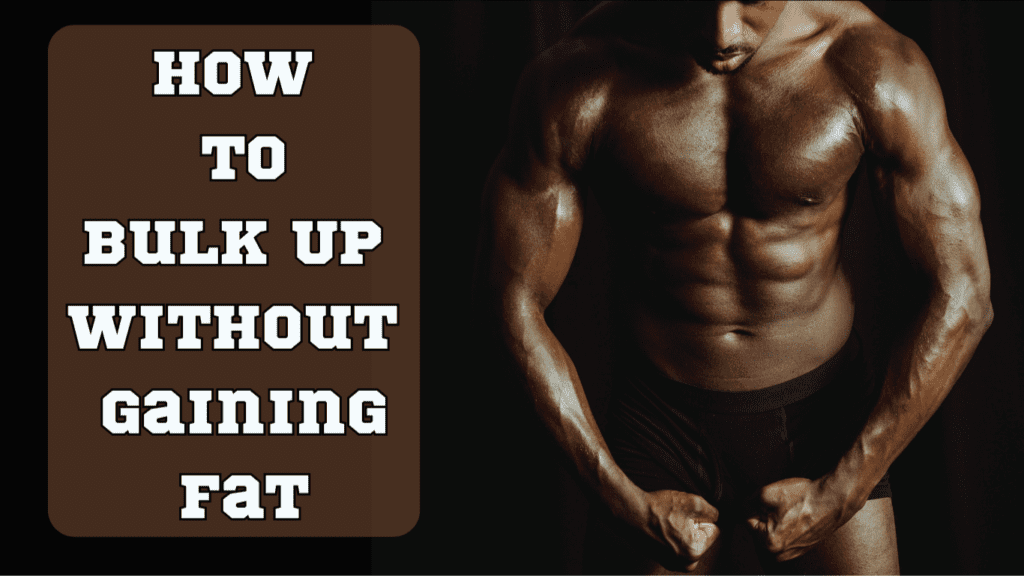
The belief that bulking up means you have to gain fat is rooted in outdated thinking. Yes, to gain muscle, you need to be in a caloric surplus—that’s non-negotiable. But how you approach that surplus, and the type of weight you gain, makes all the difference. The key is in being precise and smart about your nutrition, training, and overall lifestyle.
The goal here is not to eliminate fat gain completely—because let’s be real, that’s virtually impossible when building muscle. However, you can minimize it significantly. How? By following proven strategies that ensure your body uses most of those extra calories to fuel muscle growth instead of storing them as fat.
So how do you bulk up without gaining fat? It all boils down to three key principles: diet, training, and recovery. These three areas must work in harmony to allow you to build muscle efficiently while keeping fat gain in check.
First, let’s start with the diet. While it’s tempting to simply “eat big” to “get big,” a common mistake is overeating. Many people think that a higher caloric surplus equals more muscle, but that’s not entirely true. You only need a moderate caloric surplus to build muscle. Eating 200-300 calories above your maintenance level is usually enough to fuel muscle growth. Anything more than that tends to get stored as fat. It’s a simple, science-based fact: once your body has enough fuel to build muscle, the rest of the extra energy has nowhere to go but your fat stores.
The quality of the food you eat also plays a big role. Sure, you could bulk up by eating pizza and burgers, but that won’t help you stay lean. Instead, focus on whole foods rich in nutrients—lean proteins, complex carbohydrates, and healthy fats. Prioritizing these helps your body use those calories efficiently for muscle growth. Protein is particularly important because it’s the building block of muscle. Aim for about 0.8-1 gram of protein per pound of body weight. This ensures your muscles have the necessary nutrients to grow without packing on excess fat.
Subscribe And Get Our Free E-Book:Unlocking The Power Of Nutrition-Supplements, Substitutes, and Superfoods!
Now, let’s talk about training. If your goal is to bulk up without gaining fat, you can’t just focus on lifting heavy weights and call it a day. While resistance training is crucial for muscle growth, incorporating some cardio can help keep fat gain at bay. Steady-state cardio, like walking or light cycling, helps you burn off excess calories without interfering with muscle recovery. This doesn’t mean spending hours on the treadmill—just 20-30 minutes a few times a week can do the trick.
Another often overlooked aspect of training is progressive overload. This is the principle of gradually increasing the weight, volume, or intensity of your workouts. By consistently challenging your muscles, you stimulate them to grow, but without the need for an excessive calorie surplus. You’re making your body work smarter, not harder.
Finally, we can’t forget about recovery. Muscles don’t grow in the gym; they grow when you rest. Getting enough sleep is crucial for muscle repair and keeping your hormones balanced, including those responsible for fat storage. Aim for 7-9 hours of quality sleep each night to optimize muscle recovery and fat metabolism. Additionally, managing stress is key because chronic stress can increase cortisol levels, leading to more fat storage, especially around the midsection. So yes, the occasional Netflix binge might actually be helping your fitness goals—as long as it doesn’t replace your workouts!
To summarize this part, the idea that bulking inevitably leads to fat gain is outdated. You can definitely bulk up without gaining fat by following a strategic approach that balances your diet, training, and recovery. While some fat gain is almost inevitable when you’re in a caloric surplus, the amount can be minimized significantly. In the next part, we’ll dive deeper into how to structure your diet and training plan for lean gains and minimal fat gain, ensuring you bulk up the right way.
As you embark on your journey to bulk up without gaining unwanted fat, it’s essential to grasp the key components that contribute to successful muscle building. The following chart highlights crucial factors in maximizing muscle growth while keeping fat accumulation at bay. By integrating these elements into your training and recovery regimen, you can achieve lean muscle gains effectively.
Building Muscle, Not Fat: How to Bulk Up Without Gaining Fat Chart
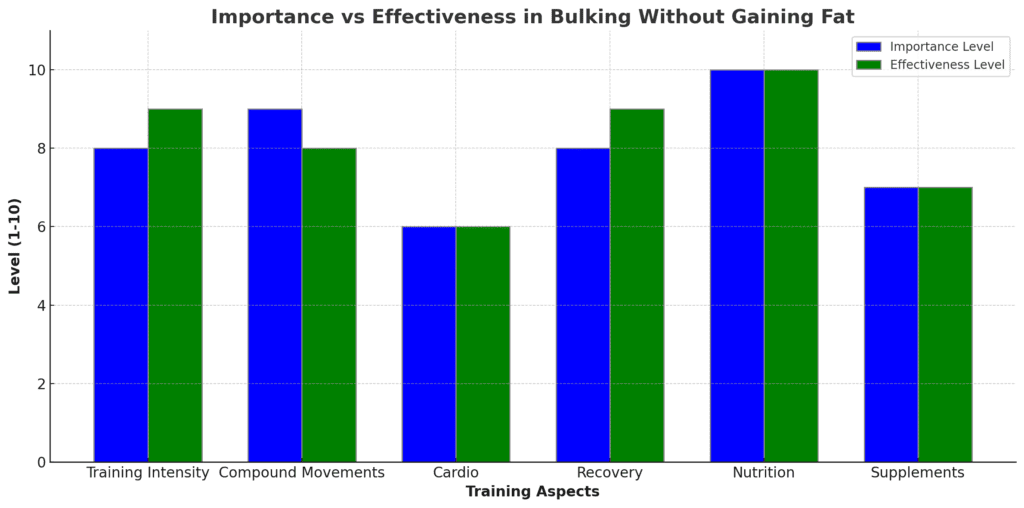
Chart Insights:
- Training Intensity: Highly important and effective. This emphasizes the need for progressive overload to stimulate muscle growth.
- Compound Movements: Both highly important and effective, showcasing their efficiency in engaging multiple muscle groups and maximizing workout results.
- Cardio: Moderately important and effective, reinforcing that while cardio can support fat management during bulking, it should be balanced with muscle-building efforts.
- Recovery: Critical in both importance and effectiveness. This aligns with the article’s emphasis on recovery as a crucial element in muscle growth.
- Nutrition: The most important aspect. This highlights the role of a nutrient-dense diet in muscle building and fat control.
- Supplements: While they can enhance results, their lower effectiveness indicates that they should be used as complementary tools rather than primary strategies.
Understanding the Science of Muscle Growth vs. Fat Gain
Did you know that the average person’s body can only build about 0.5 to 1 pound of muscle per week, even under the best conditions? This means that any extra weight you gain during a bulk is likely not muscle. This brings us to the core of this section: understanding how muscle growth and fat gain are connected and how to manage them. If you’re wondering how to bulk up without gaining fat, the answer lies in controlling the balance between your energy intake and how much of that energy your body actually uses to build muscle.
Muscle Growth and Caloric Surplus
To grow muscle, you need to be in a caloric surplus—meaning you must eat more calories than your body burns in a day. This surplus provides the energy needed for muscle tissue to repair and grow after you’ve stressed it in the gym. But here’s the catch: the amount of surplus matters. As mentioned earlier, muscle needs fuel to grow, but feed it too much, and that extra energy turns into fat. It’s a balancing act.
The key to how to bulk up without gaining fat is in the management of this caloric surplus. If you go too far over your Total Daily Energy Expenditure (TDEE), the extra calories get stored as fat, not muscle. On the flip side, if you don’t provide enough surplus, you won’t see much muscle growth. Finding that sweet spot, typically a small surplus of around 200-300 calories above your TDEE, is crucial.
Lean Bulk vs. Dirty Bulk
This brings us to two popular approaches to bulking: lean bulking and dirty bulking. Understanding the differences between them can make all the difference in your journey to build muscle effectively.
Lean bulking is a more focused and controlled approach to bulking. It involves a modest caloric surplus, usually paired with nutrient-dense foods like lean proteins, complex carbs, and healthy fats. The idea here is to provide just enough calories to build muscle while minimizing fat gain. Think of lean bulking as the slow and steady way—yes, muscle gains may take a little longer, but you’ll stay relatively lean throughout the process.
On the other hand, dirty bulking involves consuming large amounts of calories, often from less healthy sources like junk food, with the aim of rapid muscle gain. The problem is, a lot of that weight gain will be fat. The idea is that you can always cut the fat later, but the reality is that losing fat without sacrificing muscle can be more challenging than many realize. While dirty bulking may lead to faster weight gain, much of that won’t be the muscle you’re after.
If you visualize these two methods side by side, the pros and cons become clear. Lean bulking leads to steady, maintainable progress with minimal fat gain, while dirty bulking gives faster initial results but requires a longer, often harder, cutting phase later to lose the fat. For most people, the lean bulk is the better long-term strategy for how to bulk up without gaining fat.
Metabolism and Energy Balance
Your metabolism plays a huge role in determining how your body uses the energy you consume. It’s all about energy balance—how many calories you take in versus how many your body burns.
To understand this, think of your body as a machine. Your TDEE represents the total amount of calories your body needs to function each day, including everything from basic bodily functions to physical activity. When you eat exactly the amount of calories your body burns, you maintain your weight. When you eat fewer calories, you lose weight, and when you eat more calories than your body burns, you gain weight.
Now, you want to be in a caloric surplus to build muscle, but not so much that the excess gets stored as fat. Think of it this way: you need to give your body enough fuel to grow muscle, but overfilling the tank leads to spills—extra fat! A slight surplus of 200-300 calories over your TDEE is usually enough to promote muscle growth without tipping the scales too far toward fat gain. This method is the backbone of how to bulk up without gaining fat.
In addition to eating the right number of calories, paying attention to the quality of your calories also matters. Your body will make better use of lean proteins, complex carbs, and healthy fats than it will of highly processed junk foods, which are more likely to be stored as fat. Choosing the right foods ensures that your caloric surplus fuels muscle growth rather than fat storage.

In summary, managing your caloric surplus, choosing the right types of foods, and understanding your body’s energy balance are the keys to bulking up effectively. When done correctly, this strategy allows you to build muscle while minimizing fat gain, making it the best approach for anyone looking to bulk up without gaining fat.
Chart: Muscle Growth vs. Fat Gain – Key Insights and Guidelines
| Aspect | Lean Bulking | Dirty Bulking | Key Takeaways |
|---|---|---|---|
| Caloric Surplus | 200-300 calories above TDEE | Significant surplus, often exceeding 500 calories | Moderation is essential for minimizing fat gain |
| Rate of Muscle Gain | 0.5 to 1 pound per week | Faster initial gains, but with high fat accumulation | Sustainable muscle growth requires patience |
| Food Quality | Focus on whole foods (lean proteins, complex carbs) | Often includes junk food and empty calories | Nutrient-dense foods promote muscle health |
| Risk of Fat Gain | Minimal risk if managed correctly | High risk of fat gain due to poor food choices | Fat gain can complicate future weight loss |
| Post-Bulk Cutting Phase | Shorter and less challenging | Longer and more difficult to retain muscle | Lean bulk is preferable for long-term goals |
| Nutrient Ratios | 1.2-2.2 g protein/kg, moderate carbs and fats | High carbs and fats, low protein | Balanced macronutrients support muscle recovery |
| Sample Meal Ideas | Grilled chicken salad, post-workout smoothie | Pizza, burgers, sugary snacks | Meal planning is key to successful bulking |
Additional Insights:
- Metabolism’s Role: Understanding your Total Daily Energy Expenditure (TDEE) helps tailor your caloric surplus effectively. This is crucial in avoiding excess fat gain.
- Macronutrient Breakdown: Each macronutrient plays a specific role in muscle growth. A higher protein intake is essential, with carbohydrates fueling workouts and fats aiding in hormone regulation.
- Practical Tips: Include sample meals that align with the lean bulking philosophy, emphasizing whole foods that maintain energy levels and support recovery.
How to Bulk Up Without Gaining Fat Video
Nutrition Secrets for How to Bulk Up Without Gaining Fat
When it comes to nutrition and muscle growth, here’s a surprising fact: no matter how hard you train in the gym, about 80% of your results come down to what you eat. Yes, you heard that right—your diet plays a massive role in how effectively you can gain muscle and minimize fat gain. If you’re wondering how to bulk up without gaining fat, mastering your nutrition is essential.
Calculate Your Ideal Surplus
To get started, the first step in your lean bulking journey is to determine how many calories your body needs just to maintain your current weight. This number is known as your Total Daily Energy Expenditure (TDEE), and it accounts for everything from basic bodily functions like breathing to the calories you burn through daily activities and exercise. Think of your TDEE as the baseline for keeping your weight steady.
You can easily calculate your TDEE using an online calculator, or you can do a quick calculation yourself. A common formula for estimating TDEE is:
TDEE = BMR (Basal Metabolic Rate) + Activity Level
Your BMR can be calculated using the Mifflin-St Jeor formula:
- For men: BMR = (10 x weight in kg) + (6.25 x height in cm) – (5 x age in years) + 5
- For women: BMR = (10 x weight in kg) + (6.25 x height in cm) – (5 x age in years) – 161
Once you have your BMR, multiply it by your activity factor:
- Sedentary (little or no exercise): BMR x 1.2
- Lightly active (light exercise/sports 1-3 days a week): BMR x 1.375
- Moderately active (moderate exercise/sports 3-5 days a week): BMR x 1.55
- Very active (hard exercise/sports 6-7 days a week): BMR x 1.725
Once you’ve got your TDEE, aim for a small caloric surplus of around 200-300 calories above that number. This surplus provides enough fuel for muscle growth without leading to excessive fat gain, which is the key to understanding how to bulk up without gaining fat. It’s all about giving your body just enough extra energy to build muscle but not so much that the unused calories are stored as fat.
Macronutrient Breakdown
Once you know how many calories you need to consume, it’s time to break those calories down into macronutrients—protein, carbohydrates, and fats. Each of these plays a vital role in muscle growth and overall health.
Protein:
Protein is the most critical macronutrient when it comes to muscle building. It provides the building blocks (amino acids) that your muscles need to repair and grow after a workout. The recommended intake for protein during a lean bulk is around 1.2 to 2.2 grams of protein per kilogram of body weight. For example, if you weigh 70 kg (about 154 lbs), aim for 84 to 154 grams of protein per day.
Good protein sources include chicken breast, turkey, lean beef, fish, eggs, and plant-based options like tofu and lentils. Not only does protein help repair muscles, but it also keeps you feeling full, which can prevent overeating and unwanted fat gain.
Carbohydrates:
Carbs often get a bad reputation, but they are crucial when it comes to how to bulk up without gaining fat. Carbohydrates fuel your workouts and give your body the energy it needs for high-intensity strength training. Without adequate carbs, you won’t have the energy to lift heavy, which means less muscle growth.
That said, it’s important to focus on quality carbs. Rather than loading up on sugary, processed foods, aim for complex carbohydrates that provide sustained energy. Examples include oats, quinoa, brown rice, sweet potatoes, and whole-grain bread. These carbs are rich in fiber, which slows digestion and helps regulate blood sugar levels, making it easier to control hunger and reduce fat gain.
Fats:
Don’t fear fats—your body needs them for hormone regulation, particularly for maintaining healthy testosterone levels, which are essential for muscle growth. However, like carbohydrates, the type of fat matters. Focus on healthy fats like those found in avocados, nuts, seeds, olive oil, and fatty fish (like salmon). Aim to get about 20-30% of your daily calories from fats to keep your hormones balanced and your body functioning properly.
But remember, fats are more calorie-dense than carbs and protein, so a little goes a long way. A couple of tablespoons of almond butter or half an avocado can quickly add up to a significant number of calories, so keep portion sizes in check.
Practical Meal Ideas
Now that you understand the balance of macronutrients, here are some meal ideas that hit the right macro targets for lean bulking:
- Grilled chicken salad with quinoa, spinach, and avocado: This meal provides a great balance of protein, complex carbs, and healthy fats.
- Post-workout smoothie with whey protein, oats, almond butter, and a banana: This is a fast-digesting option perfect for muscle recovery after an intense workout.
- Baked salmon with sweet potatoes and steamed broccoli: Another example of a nutrient-dense, well-balanced meal that supports muscle growth without overloading you with excess calories.
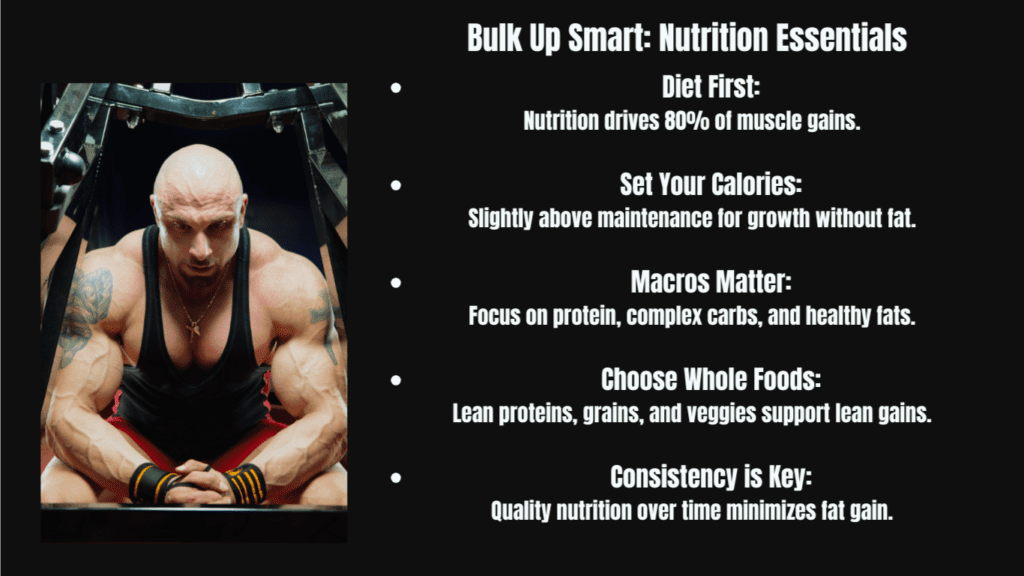
By sticking to nutrient-dense, whole foods, and maintaining that controlled caloric surplus, you can successfully bulk up while keeping fat gain to a minimum.
How to bulk up without gaining fat is all about finding the right caloric balance, focusing on quality macronutrients, and keeping your nutrition clean and strategic. With the right diet in place, you’ll give your body what it needs to build muscle without the unwanted side effect of fat gain.
Training: Maximize Muscle Growth, Not Fat
Did you know that your muscles only grow when they’re pushed beyond their normal limits? That’s why one of the key principles in building muscle is progressive overload. If you want to know how to bulk up without gaining fat, the right training approach is essential. This involves not just lifting weights, but doing so in a way that maximizes muscle growth while minimizing fat gain.
Progressive Overload
To keep building muscle, you need to keep increasing the intensity of your workouts. In simple terms, progressive overload means continually challenging your muscles by either lifting heavier weights, increasing the number of repetitions, or improving your form and control. If your workouts stay the same, your muscles will adapt and stop growing.
Think of it like this: to grow bigger muscles, you need to challenge them constantly—whether that’s by lifting heavier weights or doing more reps. Let’s say you can comfortably bench press 100 pounds for 10 reps. Once that becomes easy, it’s time to increase the weight slightly or push for a couple of extra reps. This constant progression is what forces your muscles to adapt, grow, and get stronger. Progressive overload is key when discussing how to bulk up without gaining fat, as it allows you to focus on building muscle instead of accumulating extra fat from a lack of workout intensity.
Focus on Compound Movements
When it comes to efficient muscle-building, compound exercises are your best friend. These exercises engage multiple muscle groups at once, helping you build more muscle in less time. Examples of compound exercises include squats, deadlifts, bench press, pull-ups, and overhead presses. Because these movements work large muscle groups, they also burn more calories, making them a great tool for anyone looking to gain muscle without gaining fat.
Think of compound exercises as the foundation of your muscle-building house—these big movements build the most muscle with the least wasted time. Imagine doing squats: you’re not just working your legs, but also your core, glutes, and even parts of your back. This efficiency helps ensure that your body uses the calories you’re consuming to build lean muscle rather than storing it as fat.
While isolation exercises (like bicep curls or leg extensions) can help target specific muscles, they’re best used as a supplement to compound movements. Your primary focus should be on these big, multi-joint exercises that pack a punch in terms of muscle growth and overall calorie burn.
Cardio is Not the Enemy
One of the biggest misconceptions in the fitness world is that doing cardio while bulking will kill your gains. The truth is, cardio can play an important role in keeping fat gain in check while bulking. The key is finding the right balance—too much cardio can interfere with muscle growth, but moderate cardio can actually help improve your overall fitness and prevent excessive fat accumulation.
A brisk walk or light jog a few times a week won’t burn off your muscle, but it will help keep fat in check by boosting your metabolism and maintaining cardiovascular health. If your goal is how to bulk up without gaining fat, then incorporating some form of moderate cardio is a smart strategy. Not only will it help you stay lean, but it will also improve recovery by increasing blood flow to your muscles.
One great way to include cardio without affecting your muscle-building efforts is by focusing on low-intensity steady-state (LISS) cardio, like walking, cycling, or swimming. You don’t need to spend hours on a treadmill—just 20 to 30 minutes, a few times a week, is enough to help keep your fat levels down while ensuring you’re staying fit.
Rest and Recovery Matter
Training hard is essential, but so is recovery. Your muscles don’t grow while you’re in the gym; they grow when you’re resting. That’s why it’s important to prioritize sleep and give your muscles time to recover between workouts. If you’re constantly pushing your body without adequate rest, you’ll risk injury, overtraining, and, most importantly, you won’t give your muscles the time they need to rebuild and grow.
For most people, 7-9 hours of sleep per night is ideal to ensure proper recovery. Additionally, you should avoid training the same muscle groups two days in a row. If you’re hitting chest on Monday, give those muscles at least 48 hours to recover before working them again. Recovery is crucial for how to bulk up without gaining fat because it allows your body to rebuild muscle tissue efficiently, using the calories and nutrients you’ve consumed for growth instead of fat storage.
Consistency is Key
No matter how well you train or how perfectly you balance your nutrition, none of it will matter without consistency. Building muscle and minimizing fat gain takes time and dedication. Make sure you’re regularly challenging yourself in the gym, staying on top of your nutrition, and allowing your body time to rest and recover.
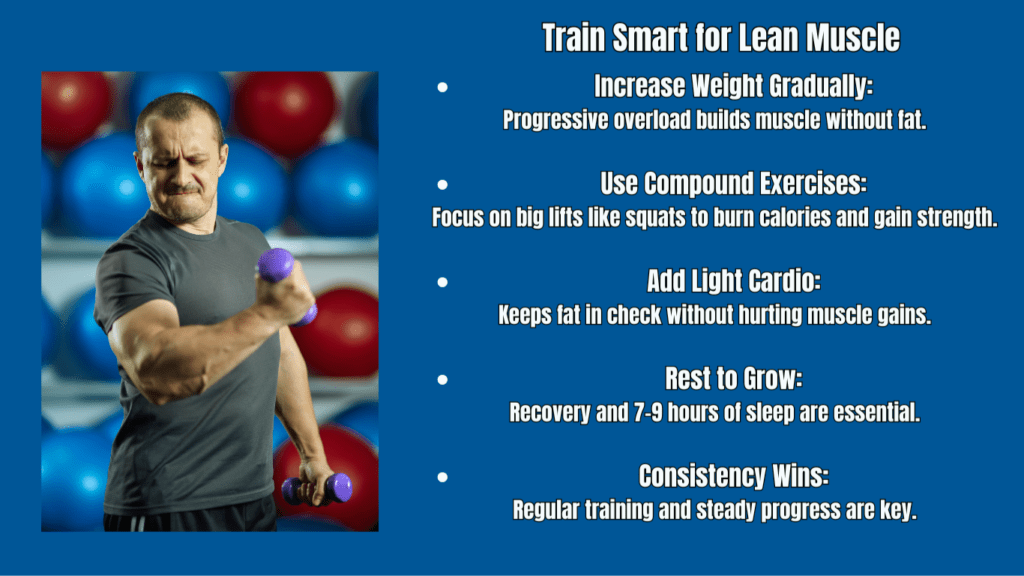
When it comes to learning how to bulk up without gaining fat, remember that small, sustainable steps are the most effective. You don’t need to add 500 pounds to your squat in a month, nor do you need to eat thousands of extra calories to see results. Consistency in your workouts, progressive overload, a nutrient-dense diet, and adequate rest will get you there.
The combination of progressive overload, compound movements, and moderate cardio will help you maximize muscle growth while keeping fat gain to a minimum. With the right training approach, you’ll be well on your way to achieving your goal of bulking up without unnecessary fat gain.
Recovery and Sleep: The Forgotten Muscle Builders
Here’s an interesting fact: Did you know that most of your muscle growth happens outside of the gym? That’s right. While lifting weights stimulates muscle fibers, recovery and sleep are where the real magic happens. If you’re serious about learning how to bulk up without gaining fat, understanding the importance of recovery is essential. You can train as hard as you want, but if your recovery game is weak, your results will be too.
The Role of Recovery
Many people overlook recovery, assuming that more time spent in the gym equals more muscle. But the truth is, muscle growth happens during rest. When you work out, you create tiny tears in your muscle fibers. These tears then need to be repaired, and when they do, your muscles grow back stronger and larger. This entire process occurs while your body is at rest, particularly during sleep.
Think of it like this: When you’re in the gym, you’re breaking your muscles down. The recovery phase is when those muscles rebuild. If you don’t give your body the chance to fully recover, you’re not allowing that rebuilding process to take place, which can ultimately slow down your progress. Rest days, as well as quality sleep, are crucial for balancing your training intensity with sufficient recovery time. This balance is key to understanding how to bulk up without gaining fat, as proper recovery prevents your body from accumulating excess fat due to overtraining or stress.
The Science of Sleep
Sleep is one of the most powerful muscle-building tools available. During deep sleep, your body releases growth hormone, which is essential for muscle repair and growth. If you skimp on sleep, you’re not just sacrificing energy and focus for your next workout—you’re actually hindering your ability to build muscle and regulate fat.
Experts recommend getting at least 7 to 9 hours of sleep per night for optimal recovery. Not only does sleep aid in muscle repair, but it also plays a role in regulating fat storage. Inadequate sleep has been linked to increased levels of the hunger hormone ghrelin, which can lead to overeating and fat gain. At the same time, your body’s ability to regulate insulin—the hormone responsible for blood sugar control—decreases when you’re sleep-deprived, making fat gain more likely.
In short, your muscles repair and grow when you sleep. Skimp on sleep, and you’re slowing down your gains. If you’re serious about learning how to bulk up without gaining fat, prioritizing sleep is non-negotiable. Aim for consistent, high-quality sleep every night, and your body will thank you.
Stress Management
Stress is another factor that can make or break your bulking efforts. When you’re under stress, your body produces higher levels of cortisol, a hormone that, when elevated for long periods, can negatively affect muscle growth and increase fat storage. Cortisol has a catabolic effect on muscles, meaning it breaks them down, making it harder to gain lean mass. Additionally, cortisol triggers the body to store fat, particularly around the abdominal area.
Learning to manage stress is crucial if you want to bulk up without gaining fat. Chronic stress not only hinders muscle growth but can also lead to overeating, especially cravings for sugary or high-fat comfort foods, which can contribute to unwanted fat gain. If you’re stressed, it can become a vicious cycle: stress increases cortisol, cortisol increases fat storage, and the resulting fatigue makes it harder to focus on good nutrition and intense workouts.
Fortunately, managing stress doesn’t have to be complicated. Simple practices like deep breathing, meditation, or even taking a day off from intense workouts can help regulate your cortisol levels. Active recovery, such as light stretching or yoga, can also aid in reducing stress without impacting muscle growth. These strategies are often overlooked but are key in the overall approach to learning how to bulk up without gaining fat.
Practical Tip
Next time you’re feeling stressed out or overwhelmed, take a few minutes to try deep breathing exercises. Inhale slowly through your nose for a count of four, hold for four seconds, then exhale through your mouth for a count of four. This simple exercise can help lower cortisol levels and bring you back into a state of calm, allowing your body to focus on muscle repair rather than fat storage.
Another practical tip is to schedule your rest days just as you would your workouts. Rest and recovery should not be an afterthought but rather an essential part of your muscle-building routine. You can try to alternate intense training days with lighter, more relaxed activities, giving your body time to recover properly. It’s a simple but effective strategy for avoiding burnout, reducing stress, and ultimately staying lean while bulking.
Final Thoughts on Recovery
Many people focus all their attention on training and nutrition, but recovery and sleep are equally important in learning how to bulk up without gaining fat. Pushing your muscles in the gym is just the beginning—without proper recovery, your muscles won’t grow. Prioritizing rest days, getting plenty of sleep, and managing stress will ensure your body can fully recover and use the nutrients you’re consuming to build lean muscle.
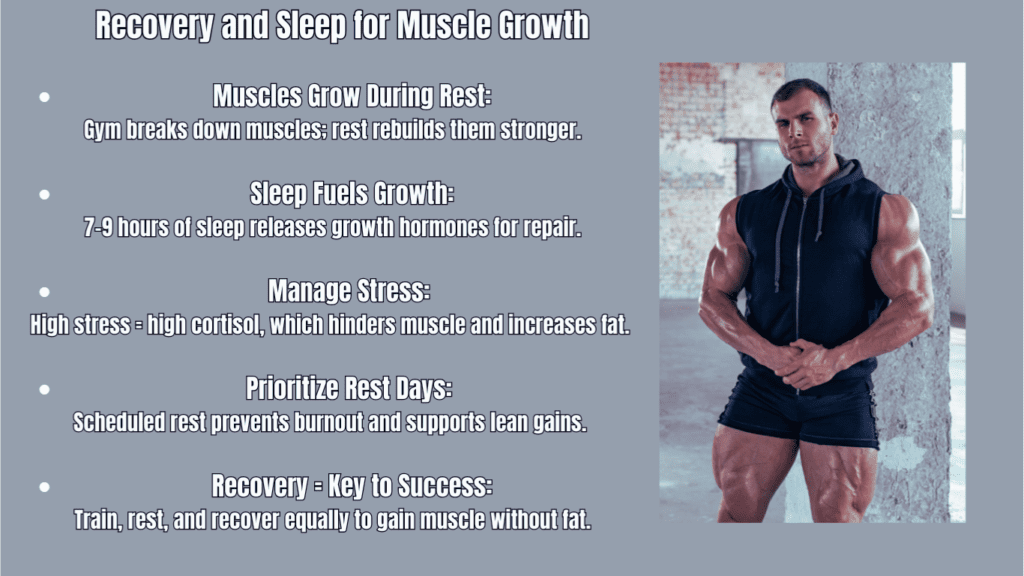
In the end, your journey to gaining muscle while minimizing fat gain comes down to balance. You need to train hard, eat smart, and rest well. By giving equal attention to recovery and sleep, you’re setting yourself up for success in building the muscle you want without packing on unnecessary fat. So next time you hit the gym, remember that the time spent recovering is just as important as the time spent lifting.
Supplements: What Works, What Doesn’t
When it comes to supplements, it’s easy to feel like you’re in a candy store, except the candies promise to make you stronger, faster, and leaner all at once. The joke? Half of them don’t actually do anything! Fun fact: The supplement industry is worth billions of dollars, but a significant chunk of that is spent on products that haven’t been proven to work. If you’re serious about how to bulk up without gaining fat, you need to know what works and what doesn’t.
Protein Powder
Let’s start with one of the most popular supplements out there: protein powder. Whether it’s whey, casein, or plant-based, protein powder is a convenient way to ensure you hit your daily protein intake, which is crucial for muscle growth. Your muscles need protein to repair and grow, and many people struggle to get enough through whole foods alone, especially if they’re busy or on the go.
But here’s the thing: protein powder isn’t necessary if you’re already consuming enough protein from whole food sources like chicken, fish, eggs, and legumes. If you’re able to meet your daily protein target (typically 1.2–2.2 g of protein per kilogram of body weight) with meals alone, you don’t need to add protein shakes into the mix. That said, for many people, protein powder can be an easy and quick way to ensure they’re getting enough protein, especially after a workout.
So, if you’re aiming to learn how to bulk up without gaining fat, protein powder can be a helpful tool, but it’s not a magic bullet. Don’t overdo it with shakes, and always aim to prioritize real food first.
Creatine
If there’s one supplement that’s backed by mountains of research, it’s creatine. In fact, creatine is one of the most studied supplements out there, and the science consistently shows that it works. Creatine helps your muscles produce more energy during high-intensity exercise, which allows you to lift heavier weights and perform more reps. Over time, this increased workload helps you build more muscle.
Creatine monohydrate, the most common form, is safe, effective, and relatively inexpensive. Taking about 3–5 grams per day can increase your muscle strength and size, making it easier to hit your muscle-building goals. It’s also worth noting that creatine helps with muscle hydration, which gives your muscles a fuller look—an added bonus for anyone aiming to bulk up.
When it comes to how to bulk up without gaining fat, creatine is a supplement that works as part of an overall smart nutrition and training plan. It won’t make you gain fat; in fact, it’s more likely to support lean muscle gains when paired with consistent strength training.
Avoid Gimmicks
The world of supplements is filled with gimmicks and marketing promises that sound too good to be true. That’s because, in most cases, they are. One of the most common traps people fall into is the lure of fat burners. These supplements claim to help you lose fat while building muscle, but the reality is that most fat burners are filled with stimulants like caffeine, which may boost energy temporarily but do little to change your body composition in a meaningful way.
There’s no need to rely on flashy products that promise overnight results or unrealistic transformations. The truth is, if you want to know how to bulk up without gaining fat, your time and money are better spent focusing on proven methods like proper nutrition, consistent training, and adequate recovery. Fat burners, testosterone boosters, and other so-called “miracle” pills often come with little scientific backing and can be a waste of both effort and resources.
As an example: “Stick with science-backed supplements, and avoid anything that promises unrealistic results—there’s no magic pill!” Building muscle while minimizing fat requires hard work and patience, not shortcuts.
Vitamins and Minerals
Although not as exciting as protein powder or creatine, vitamins and minerals play a crucial role in your body’s ability to recover and perform optimally. Ensuring you’re getting enough of key nutrients like vitamin D, magnesium, and zinc can help support muscle function, recovery, and hormone regulation.
For instance, vitamin D is essential for bone health and muscle function, and many people are deficient in it, especially in areas with less sunlight. Magnesium plays a role in muscle relaxation and recovery, while zinc is critical for hormone production, including testosterone. If you’re not getting enough of these nutrients through your diet, a basic multivitamin can help fill the gaps, but you don’t need anything fancy.
Caffeine
We can’t forget about one of the most popular supplements out there: caffeine. Whether it’s through coffee, pre-workout supplements, or energy drinks, caffeine can be a helpful tool to improve workout performance. Caffeine increases focus, energy, and endurance, making it easier to push through tough workouts. Just be mindful of your intake, as too much caffeine can interfere with sleep, which, as we discussed earlier, is crucial for recovery and muscle growth.
When taken in moderation, caffeine can be a useful addition to your supplement routine, especially if you’re training early in the morning or need an extra boost of energy for your workout. However, like all supplements, it’s not a necessity—if you’re feeling good without it, there’s no need to force it into your routine.
Final Thoughts on Supplements
Supplements can be helpful, but they’re not magic. The most important factors in learning how to bulk up without gaining fat are still proper nutrition, training, and recovery. Supplements like protein powder and creatine can enhance your progress, but they won’t do the work for you. Avoid falling for the hype around unproven supplements like fat burners, and instead, focus on science-backed options that complement your overall fitness plan.
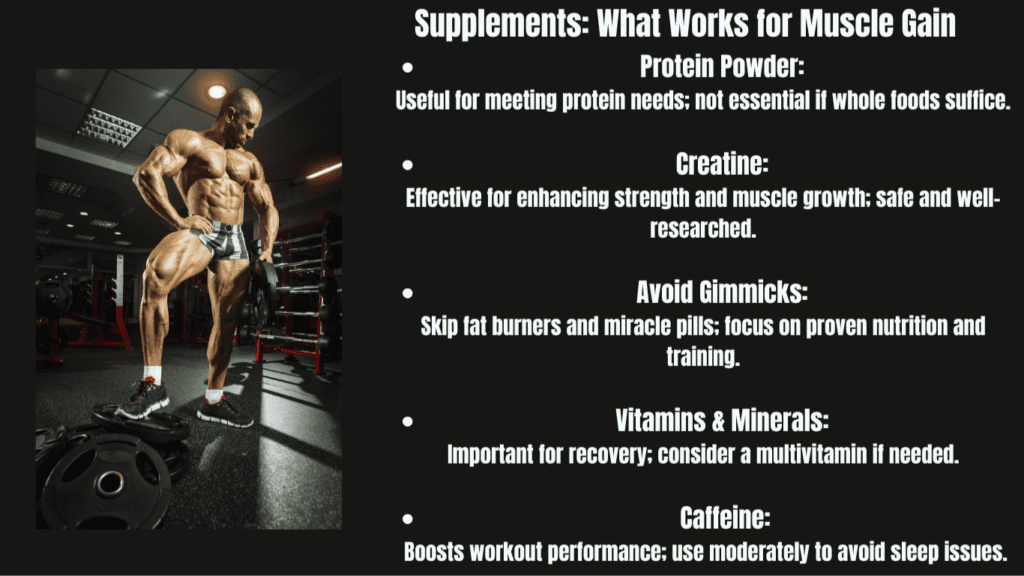
In the end, supplements are just that—supplements. They’re there to fill in the gaps, not replace the foundation of your muscle-building strategy. Keep things simple, stick to what works, and remember that consistency in your diet and training will always deliver better results than any supplement ever could.
Tracking Progress: Adjust as You Go
They say the scale never lies, but if it could talk, it might say, “I’m not telling you the full story!” Fun fact: Your weight can fluctuate by several pounds in a single day, depending on things like water retention and food intake. That’s why when learning how to bulk up without gaining fat, relying on the scale alone can be misleading. Instead, a more well-rounded approach to tracking progress will give you a clearer picture of your muscle gains and fat levels over time.
Use Body Measurements, Not Just Weight
It’s tempting to obsess over the number on the scale, especially when you’re in a bulking phase. However, that number doesn’t always reflect what’s really going on with your body. Your weight includes not only muscle but also water, fat, and even the contents of your stomach on any given day. That’s why it’s crucial to track your progress through body measurements, not just your weight.
Taking measurements of key areas like your waist, chest, arms, and legs will give you a much clearer idea of whether you’re building muscle or gaining fat. If your waist measurement is increasing significantly, but your arms and chest aren’t, it could indicate that you’re gaining more fat than muscle. On the other hand, if your arms, chest, and legs are getting bigger while your waist stays relatively the same, it’s a good sign that your muscle mass is increasing.
Another great way to track progress is by using progress photos. You don’t need to be a bodybuilder to benefit from taking regular photos of yourself. A picture every couple of weeks can reveal changes that the scale won’t, allowing you to visually see how your body composition is shifting.
Clothing fit is another easy way to gauge your progress. If your shirts are getting tighter in the chest and arms, but your pants still fit comfortably around the waist, it’s a strong sign that you’re adding lean muscle without excess fat.
In short, to really understand how to bulk up without gaining fat, you need to go beyond the scale and track your progress through measurements, photos, and how your clothes fit. This will give you a more accurate sense of whether you’re on track or if you need to make adjustments.
Action Step: Start by taking measurements of your waist, arms, chest, and thighs every couple of weeks, and compare them over time. Keep a record, and pair it with progress photos taken in the same lighting and clothing for consistency.
Adjust Your Plan as Needed
The journey of bulking up without gaining fat isn’t a one-size-fits-all process. As your body changes, your plan should, too. If you’re noticing that your measurements are showing an increase in fat around the waist or belly, it’s time to adjust your calorie intake. While muscle growth requires a caloric surplus, gaining too much fat means you’re likely overfeeding your body. In that case, dial back the calories slightly—perhaps by reducing your surplus by 100-200 calories a day.
On the flip side, if you’re not gaining weight at all, or if your measurements aren’t improving, it could mean that you’re not eating enough. In that case, it might be time to bump up your calories by 200-300 per day. Remember, this is a gradual process, and the key is making small adjustments to keep yourself in that ideal muscle-building zone without excess fat gain.
If you’re gaining too much fat, don’t panic. It’s a natural part of the bulking process, but you have the power to control it. Simply reduce your calorie intake slightly and make sure you’re sticking to your training program. On the other hand, if you’re seeing minimal progress, don’t be afraid to increase your calories a bit to fuel those muscles.
The Importance of Patience
Bulking up without gaining significant fat isn’t something that happens overnight. It requires patience, consistency, and, most importantly, being willing to adjust as you go. If you’re checking your measurements and photos every week and expecting dramatic changes, you might be setting yourself up for disappointment. Muscle gain is a slow process, and you might only see minor improvements every couple of weeks. That’s okay! The key is consistent progress, not rapid change.
If, after several weeks, you’re seeing your waistline expand more than your muscles, it’s time to reassess your approach. You might need to increase the intensity of your workouts, add a bit more cardio, or reduce your calorie intake slightly. On the other hand, if your arms, chest, and legs aren’t growing, you could be under-eating or not pushing hard enough in your strength training.
Action Step: Make adjustments every 2-4 weeks based on your progress. If fat gain seems to be creeping up, reduce your calorie intake slightly. If muscle gains are stalling, increase your calories or training intensity.
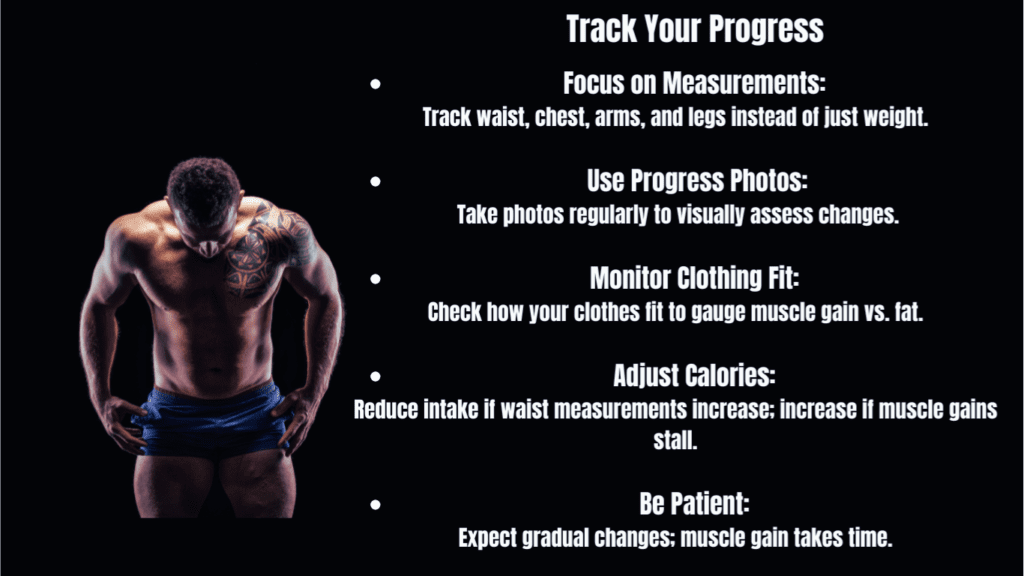
Tracking progress when figuring out how to bulk up without gaining fat is all about balance. The scale can provide some information, but body measurements, progress photos, and how your clothes fit are much more reliable ways to gauge your success. Be prepared to adjust your plan as you go—whether that’s by tweaking your calorie intake or changing up your workouts. This flexible, measured approach will help you build muscle while minimizing fat gain over time.
Common Mistakes to Avoid
Did you know that even the most dedicated fitness enthusiasts can derail their progress with a few common mistakes? It’s true! When learning how to bulk up without gaining fat, avoiding pitfalls is just as crucial as following the right steps. Let’s take a look at some of the common mistakes people make during their bulking phase and how you can sidestep them.
Overeating “Healthy” Foods
One of the most common traps people fall into is the idea that they can eat unlimited quantities of “healthy” foods without consequences. Just because a food is deemed nutritious doesn’t mean it’s calorie-free. In fact, overeating healthy foods can lead to excess calorie consumption, which ultimately results in fat gain. For example, nuts, avocados, and whole grains are all great choices, but their calorie density can add up quickly.
While it’s important to prioritize whole, nutrient-dense foods in your diet, it’s equally important to be mindful of portion sizes. A handful of almonds may be healthy, but it’s still packed with calories. Instead of viewing healthy foods as limitless, aim to integrate them into a well-structured meal plan that aligns with your caloric surplus goals. Balancing the intake of these foods will help you stay on track and make the most of your bulking phase.
Underestimating Liquid Calories
Another sneaky source of calories comes from liquid sources. It’s easy to overlook the number of calories in smoothies, protein shakes, and even juices. For instance, while a smoothie might seem like a healthy option packed with fruits and vegetables, it can also contain a surprising amount of calories—especially if you’re adding ingredients like nut butter or full-fat yogurt.
To ensure that you’re still effectively navigating how to bulk up without gaining fat, keep an eye on the calories in your liquid meals. You might be consuming more calories than you think if you’re not measuring your portions carefully. Instead of just focusing on solid foods, remember that these drinks contribute to your overall caloric intake. When blending your favorite smoothie, consider tracking the calories from each ingredient to avoid unintentional overconsumption.
Neglecting Cardio
While it may seem counterintuitive to include cardio during a bulking phase, neglecting it can lead to unwanted fat gain. Many people assume that cardio is only for cutting or losing weight, but the truth is that moderate cardio can be an essential component of a successful bulking strategy. Not only does it help maintain cardiovascular health, but it also aids in managing fat gain.
Think of it this way: Incorporating cardio sessions a few times a week can help you burn extra calories, allowing you to enjoy your meals without packing on excess fat. It also improves recovery times and overall fitness levels. By striking a balance between strength training and cardio, you can still achieve the muscle growth you desire while minimizing fat accumulation.
Overtraining
It might seem like the more you work out, the better your results will be, but overtraining can be a significant hindrance to your progress. Working out excessively without adequate recovery time can lead to burnout, injury, and stalled muscle growth. It’s crucial to allow your body the rest it needs to recover and repair itself.
To achieve the goal of how to bulk up without gaining fat, it’s essential to listen to your body. Incorporating rest days and focusing on quality workouts instead of quantity will help you build muscle efficiently. Proper recovery not only aids in muscle repair but also helps maintain motivation and prevent fatigue. Consider implementing structured rest days into your training routine and pay attention to how your body responds.
Being aware of these common mistakes will empower you to make more informed choices during your bulking journey. Overeating “healthy” foods, underestimating liquid calories, neglecting cardio, and overtraining are all pitfalls that can derail your progress. By staying mindful of these factors, you’ll be better equipped to navigate the path of how to bulk up without gaining fat successfully.
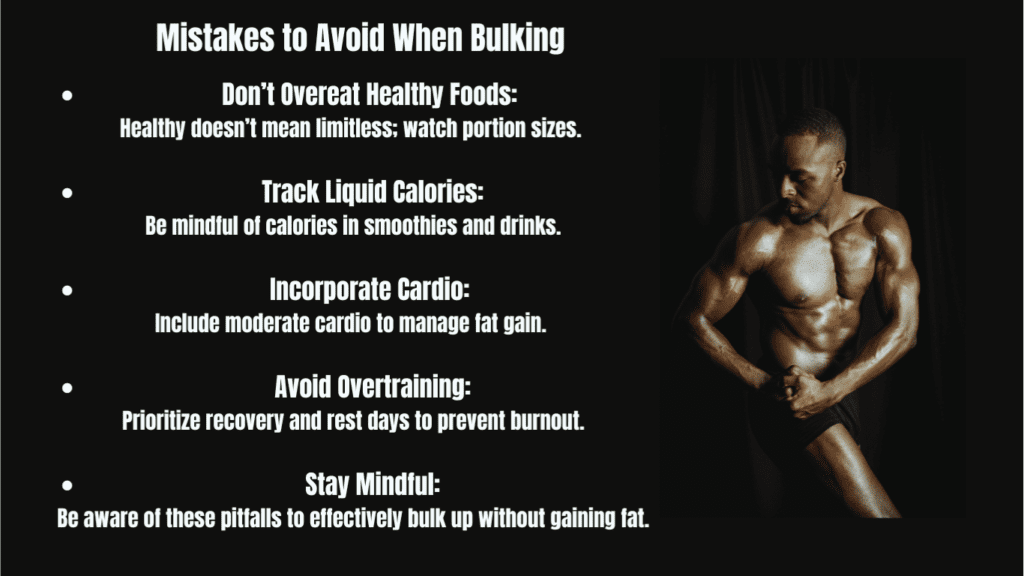
To summarize, here are some actionable steps you can take:
- Monitor Portion Sizes: Just because a food is healthy doesn’t mean you can eat it in unlimited amounts.
- Track Liquid Calories: Be mindful of what you’re drinking. Count those calories like you would with solid foods.
- Incorporate Cardio: Aim for a few sessions each week to maintain cardiovascular health and keep fat gain in check.
- Prioritize Recovery: Listen to your body, and ensure you have rest days to avoid burnout and injuries.
By keeping these tips in mind, you’ll have a better chance of achieving your goals while successfully learning how to bulk up without gaining fat.
Realistic Expectations: How to Bulk Up Without Gaining Fat
Why did the bodybuilder bring a ladder to the gym? Because he heard that’s where the gains are! While we can all appreciate a good laugh, when it comes to how to bulk up without gaining fat, there’s no shortcut to success. In fact, many people overlook the fact that building muscle is a gradual process that requires patience and realistic expectations.
Setting Realistic Goals
One of the most critical aspects of embarking on a muscle-building journey is setting realistic goals. It’s essential to understand that muscle gain is a slow process for most individuals. Aiming for 0.5 to 1 pound of muscle gain per week is a realistic target. If you’re seeing consistent progress, you’re on the right track. Keep in mind that building muscle without fat isn’t a sprint—it’s more like a marathon. Don’t expect overnight results; instead, focus on the long game. Each week, assess your progress and make adjustments as necessary.
Many people fall into the trap of comparing themselves to others, often leading to frustration. Remember, everyone’s body responds differently to training and nutrition. Some may see gains faster than others, but this doesn’t diminish your progress. When you set goals that are achievable and measurable, you’re more likely to stay motivated and committed to your journey of how to bulk up without gaining fat.
Celebrate Small Wins
Another important aspect of maintaining motivation is to celebrate small wins along the way. These victories can be as simple as lifting a heavier weight, improving your workout endurance, or noticing slight changes in muscle definition. Acknowledge the efforts you’re putting in—whether it’s being consistent with your diet, pushing through a tough workout, or sleeping better.
Taking time to appreciate these small achievements helps keep your morale high and reinforces your commitment to your goals. After all, muscle growth is a cumulative process that builds over time. When you celebrate your progress, no matter how minor, you remind yourself of the effort and dedication it takes to learn how to bulk up without gaining fat.
Understanding Patience
Patience is key in this journey. Sometimes, the scale may not reflect the hard work you’re putting in, and that’s completely normal. Muscle is denser than fat, which means that even if you’re gaining muscle, your weight may not change dramatically. This is where measurements and progress photos come in handy. When tracking your progress, focus on how your body feels and how your clothes fit rather than just the numbers on the scale.
Remember, how to bulk up without gaining fat is about creating a sustainable lifestyle. Quick fixes and extreme diets often lead to disappointment and burnout. Instead, commit to steady progress. When you approach muscle gain with a mindset of patience and perseverance, you’re setting yourself up for long-term success.
Track Your Progress
To further aid in managing your expectations, consider keeping a progress journal. Document your workouts, diet, and any changes you notice in your body. This record can be invaluable when reflecting on your journey and seeing how far you’ve come. It serves as a reminder that every step counts, and the cumulative effect of your efforts will lead to the results you desire.
In your journal, you can note down your workouts, how much weight you lifted, and any increases in your reps or sets. Additionally, you can keep track of your body measurements, noting any changes in your waist, arms, or chest. Over time, these small changes will lead to significant transformations, helping you understand the concept of how to bulk up without gaining fat.
Focus on Consistency
Ultimately, the key to muscle growth is consistency. Staying dedicated to your training, nutrition, and recovery will yield the best results. Rather than expecting immediate changes, trust in the process and commit to your goals. Consistency is the backbone of progress, and with it, you’ll be able to see the fruits of your labor.
Every individual’s journey will look different, and that’s what makes it unique. Don’t rush the process. Building muscle takes time, and the patience you cultivate now will pay off later. Embrace each stage of your journey, and remember that learning how to bulk up without gaining fat is about developing a lifestyle that supports your goals in the long run.
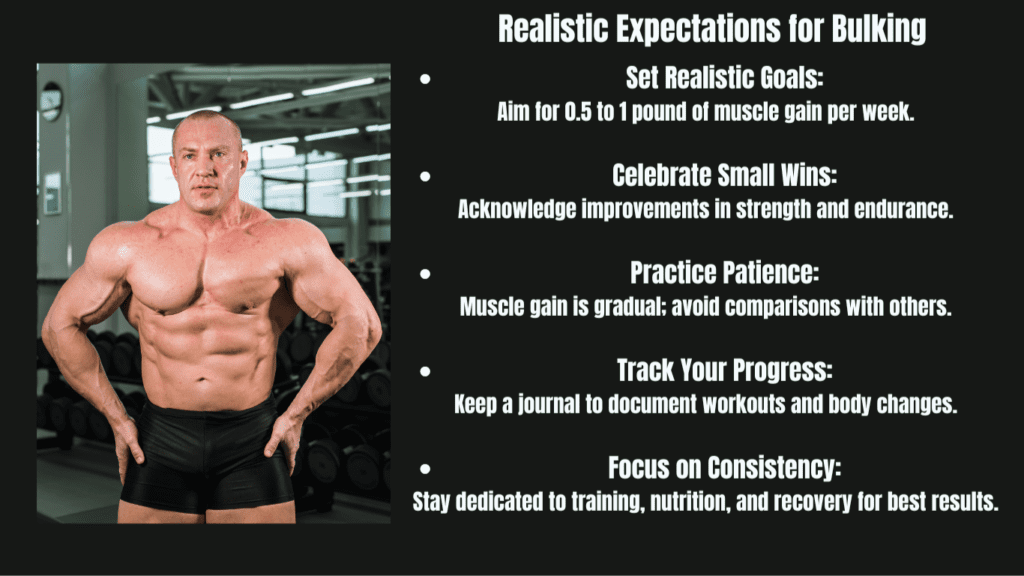
In conclusion, keep these points in mind as you embark on your bulking journey:
- Set Realistic Goals: Aim for 0.5 to 1 pound of muscle gain per week and focus on gradual progress.
- Celebrate Small Wins: Acknowledge improvements in strength, endurance, and body composition.
- Practice Patience: Understand that muscle gain is a slow process; avoid comparing yourself to others.
- Track Your Progress: Keep a journal to document your workouts, diet, and changes in your body.
By adhering to these principles, you’ll be well on your way to mastering how to bulk up without gaining fat and achieving the physique you desire. Remember, consistency and patience are your best allies on this journey!
Recap and FAQs: How to Bulk Up Without Gaining Fat
As we wrap up our discussion on how to bulk up without gaining fat, it’s essential to take a moment to recap the key points we’ve covered. Building muscle while minimizing fat gain is not just about lifting weights or consuming more calories; it’s a well-rounded approach that includes nutrition, training, recovery, and most importantly, patience. Let’s recap the major elements we explored throughout this guide.
- Understanding Muscle Growth vs. Fat Gain: It’s crucial to recognize that a caloric surplus is necessary for muscle growth. However, managing that surplus wisely is what sets the successful bulker apart from those who struggle with excess fat gain.
- Nutrition: The Key to Lean Bulking: We emphasized the importance of calculating your Total Daily Energy Expenditure (TDEE) and setting a moderate caloric surplus. With the right macronutrient balance—especially a high protein intake—you can fuel your muscles effectively while keeping fat gain in check.
- Training: Maximize Muscle Growth, Not Fat: We discussed the principle of progressive overload and the benefits of focusing on compound movements. These strategies help ensure your workouts are efficient and effective, promoting muscle growth without unnecessary fat accumulation.
- Recovery and Sleep: The Forgotten Muscle Builders: Recovery is just as vital as the workouts themselves. Your muscles need adequate rest and sleep to repair and grow, so prioritizing sleep and stress management is essential for optimal gains.
- Supplements: What Works, What Doesn’t: We touched on the importance of science-backed supplements like protein powder and creatine, while advising against gimmicky products that promise unrealistic results. Remember, there’s no magic pill for building muscle without fat.
- Tracking Progress: Adjust as You Go: Understanding that weight isn’t the only measure of success is vital. By taking measurements, photos, and adjusting your plan based on your results, you can fine-tune your approach and stay on track.
- Common Mistakes to Avoid: We covered potential pitfalls like overeating “healthy” foods and neglecting cardio. Avoiding these mistakes helps keep your fat gain in check while you bulk up.
- Realistic Expectations and Patience: Lastly, we emphasized that building muscle is a gradual process. Setting realistic goals and celebrating small wins can keep you motivated throughout your journey.

Frequently Asked Questions (FAQs)
- What is a caloric surplus?
- A caloric surplus occurs when you consume more calories than your body burns, which is necessary for muscle growth.
- How do I calculate my TDEE?
- You can calculate your TDEE using online calculators or formulas that consider your age, weight, height, and activity level.
- What’s the ideal macronutrient ratio for bulking?
- A common guideline is to aim for 25-35% protein, 45-60% carbohydrates, and 20-30% fats, though this can vary based on individual goals.
- How much protein should I consume daily?
- Aim for approximately 1.2 to 2.2 grams of protein per kilogram of body weight, depending on your activity level and goals.
- Can I bulk without gaining any fat?
- While it’s nearly impossible to eliminate fat gain entirely, you can minimize it through careful diet and training strategies.
- Is cardio necessary while bulking?
- Yes, moderate cardio helps maintain cardiovascular health and can aid in keeping fat gain in check.
- What role does sleep play in muscle growth?
- Sleep is essential for recovery and muscle repair. Aim for 7-9 hours of quality sleep each night.
- Are supplements necessary for bulking?
- Supplements can help but aren’t required. Prioritize whole foods first. Protein powder can be a convenient option if you struggle to meet your protein needs.
- How long will it take to see results from bulking?
- Muscle gain is a slow process, and you may start noticing changes within a few weeks to months, depending on consistency and effort.
- What are some signs of overtraining?
- Signs include fatigue, decreased performance, irritability, and persistent soreness. Make sure to incorporate rest days and listen to your body.
Final Thoughts
We hope this guide has equipped you with the knowledge and strategies to successfully navigate how to bulk up without gaining fat. Remember, your body can build muscle without packing on fat, but it requires patience, precision, and a smart approach. We encourage you to share your experiences in the comments section below. Let’s learn from each other and continue to support one another on this journey!
You’ve got this!


